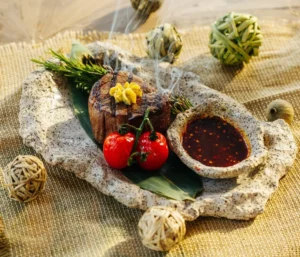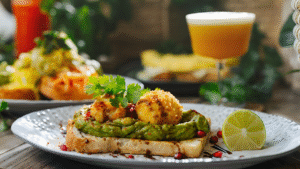You’ve seen it on luxury menus, heard celebrities rave about it, and maybe even spotted it delicately served on tiny spoons. But you might still be wondering, what is caviar exactly, and why is it such a delicacy?
Caviar is one of the most sought-after gourmet foods in the world, often associated with fine dining, elegance, and celebration. While it might seem like a mystery to those new to it, understanding this luxury ingredient can be simple and even exciting.
Whether you’re hosting a dinner party or just exploring new flavors, this guide explains what caviar is, where it comes from, how it tastes, and how to enjoy it to the fullest.
What Is Caviar Made Of?
Let’s start with the basics.
Simply put, caviar is the salt-cured eggs (roe) of the sturgeon fish. Not all fish eggs are considered caviar, the term traditionally refers only to the roe from sturgeon species, such as Beluga, Ossetra, or Sevruga.
These fish are mostly found in the Caspian and Black Seas, though sustainable farms around the world now produce high-quality caviar. The process of harvesting, cleaning, salting, and aging the roe is delicate and precise, which is one reason caviar is so valuable.
What Is Caviar Food?
So, what is caviar food, exactly?
It’s a refined ingredient served cold, often on its own or with light accompaniments that don’t overpower its taste. Caviar is not a dish in itself but rather a luxurious topping or appetizer, known for its smooth texture and briny, complex flavor.
You’ll often find caviar on blinis (small pancakes), toast points, or paired with sour cream and herbs. It can also be used as a garnish on seafood, eggs, or even pasta for a sophisticated twist. This is one of the main parts of dinner in Dubai.
Caviar: What Is It Used For?
Still thinking, caviar, what is it used for?
In fine dining, caviar is used to enhance both flavor and visual presentation. It adds richness, a pop of salt, and an elegant touch to any dish. Because it’s delicate, it’s usually added at the last moment.
Caviar is also enjoyed by itself, served in small portions on a non-metal spoon (usually mother-of-pearl or bone), which prevents the flavor from being altered. A glass of Champagne or chilled vodka is often served alongside to cleanse the palate. In addition, adding caviar to the eggs makes it a healthy breakfast.
What Is the Taste of Caviar?
Curious about the taste of caviar?
It depends on the type, but in general, caviar has a buttery texture, a slight pop when bitten into, and a flavor that ranges from mildly salty to nutty and creamy.
High-quality caviar should not taste fishy. Instead, you’ll get subtle oceanic notes, a touch of brine, and an almost creamy finish. Like fine wine or cheese, each variety has its own unique taste profile, which can change based on how the roe was processed and aged.
What Fish Is Caviar From?
You might wonder, what fish is caviar from?
True caviar comes only from sturgeon, a group of ancient fish known for producing large, rich roe. There are several types of sturgeon used for caviar.
First of all, it comes from beluga sturgeon, which produces large, soft pearls with a delicate taste. The second one is ossetra sturgeon, which is known for nutty, medium-sized eggs. Lastly, it comes from sevruga sturgeon, offering smaller, more intensely flavored eggs.
Other fish, like salmon or trout, also produce roe, but these are labeled as “salmon roe” or “trout roe,” not caviar by traditional definition.
Serving Suggestions and Pairing Tips
Now that we’ve answered what is caviar, let’s talk about how to serve it.
Caviar should always be served cold, preferably in its tin placed over crushed ice. A serving size is small, about 1 to 2 teaspoons per person, and should be enjoyed slowly.
Caviar is best enjoyed in simple, elegant ways that highlight its delicate flavor. One of the most classic serving methods is on blinis, which are small, soft pancakes, and are topped with a small dollop of crème fraîche, which adds a creamy contrast.

Another refined option is to pair it with boiled quail eggs or soft-boiled chicken eggs, offering a rich, smooth base that complements the brininess of the roe. For a fun, modern twist, caviar can be served over potato chips or thin potato slices, adding a salty crunch and casual elegance.
Lastly, lightly buttered toast or crisp crackers make excellent vehicles for caviar, offering both texture and a neutral background that lets the roe shine.
As for drinks, caviar pairs best with dry, clean flavors that don’t overpower it. Champagne, dry white wines, or chilled vodka are traditional choices. Sparkling water with lemon also works for a non-alcoholic option.
Storing and Handling Caviar
Caviar is sensitive to heat, air, and metal. Once opened, it should be consumed within a couple of days and stored in the coldest part of your fridge. Always use non-metallic spoons or utensils to avoid altering the flavor.
Conclusion
Understanding what caviar is opens the door to a luxurious world of flavor and fine dining. It’s more than just fish eggs, it’s a centuries-old delicacy, valued for its texture, taste, and elegance. Whether served on a blini or enjoyed straight from the tin, caviar is a special experience.
Next time you’re looking to elevate your dinner table or celebrate a milestone, consider caviar, a small ingredient that makes a big impression. Also, if you want to enjoy caviar, come to BohoX or call at 052 103 2646 to make a reservation.
Know More
Frequently Asked Questions
Is caviar always expensive, or are there affordable options?
Can you cook with caviar, or should it always be served cold?
How should beginners try caviar for the first time?
Is caviar considered sustainable or environmentally friendly?
Wild sturgeon are endangered, but sustainable, farm-raised caviar is widely available. Choose ethically farmed, certified brands to enjoy caviar responsibly while supporting environmental conservation and protecting endangered species.





